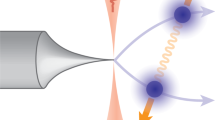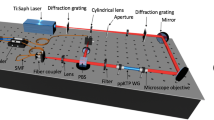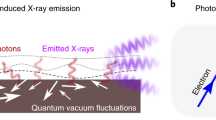Abstract
Photon number distributions of classical and non-classical light sources have been studied extensively, yet their impact on photoemission processes is largely unexplored. In this article, we present measurements of electron number distributions from metal needle tips illuminated with ultrashort light pulses with various photon quantum statistics. By varying the photon statistics of the exciting light field between classical (Poissonian) and quantum (super-Poissonian), we demonstrate that the measured electron distributions are changed substantially. Using single-mode bright squeezed vacuum light, we measure extreme statistics events with up to 65 electrons from one light pulse at a mean of 0.27 electrons per pulse—the likelihood for such an event equals 10−128 with Poissonian statistics. By changing the number of modes of the exciting bright squeezed vacuum, we can tailor the electron number distribution on demand. Most importantly, our results demonstrate that the photon statistics is imprinted from the driving light to the emitted electrons, opening the door to new sensor devices and to strong-field optics with quantum light and electrons.
This is a preview of subscription content, access via your institution
Access options
Access Nature and 54 other Nature Portfolio journals
Get Nature+, our best-value online-access subscription
$29.99 / 30 days
cancel any time
Subscribe to this journal
Receive 12 print issues and online access
$209.00 per year
only $17.42 per issue
Buy this article
- Purchase on Springer Link
- Instant access to full article PDF
Prices may be subject to local taxes which are calculated during checkout



Similar content being viewed by others
Data availability
Source data are provided with this paper. All other data that support the plots within this paper and other findings of this study are available from the corresponding author upon reasonable request.
References
L’Huillier, A., Lompre, L. A., Mainfray, G. & Manus, C. Multiply charged ions formed by multiphoton absorption processes in the continuum. Phys. Rev. Lett. 48, 1814–1817 (1982).
Ferray, M. et al. Multiple-harmonic conversion of 1064 nm radiation in rare gases. J. Phys. B At. Mol. Opt. Phys. 21, 31–35 (1988).
Corkum, P. B. Plasma perspective on strong field multiphoton ionization. Phys. Rev. Lett. 71, 1994–1997 (1993).
Lewenstein, M., Balcou, P., Ivanov, M. Y., L’Huillier, A. & Corkum, P. B. Theory of high-harmonic generation by low-frequency laser fields. Phys. Rev. A 49, 2117–2132 (1994).
Baltuška, A. et al. Attosecond control of electronic processes by intense light fields. Nature 421, 611–615 (2003).
Schultze, M. et al. Delay in photoemission. Science 328, 1658–1662 (2010).
Krausz, F. & Stockman, M. I. Attosecond metrology: from electron capture to future signal processing. Nat. Photonics 8, 205–213 (2014).
Tsatrafyllis, N., Kominis, I.K., Gonoskov, I.A. & Tzallas, P. High-order harmonics measured by the photon statistics of the infrared driving-field exiting the atomic medium. Nat. Commun. 8, 15170 (2017); https://doi.org/10.1038/ncomms15170
Tsatrafyllis, N. et al. Quantum optical signatures in a strong laser pulse after interaction with semiconductors. Phys. Rev. Lett. 122, 193602 (2019); https://doi.org/10.1103/physrevlett.122.193602
Lewenstein, M. et al. Generation of optical Schrödinger cat states in intense laser-matter interactions. Nat. Phys. 17, 1104–1108 (2021).
Gorlach, A., Neufeld, O., Rivera, N., Cohen, O. & Kaminer, I. The quantum-optical nature of high harmonic generation. Nat. Commun. 11, 4598 (2020); https://doi.org/10.1038/s41467-020-18218-w
Stammer, P. et al. Quantum electrodynamics of intense laser-matter interactions: a tool for quantum state engineering. PRX Quantum 4, 010201 (2023); https://doi.org/10.1103/prxquantum.4.010201
Gorlach, A. et al. High-harmonic generation driven by quantum light. Nat. Phys. 19, 1689–1696 (2023).
Even Tzur, M. & Cohen, O. Motion of charged particles in bright squeezed vacuum. Light Sci. Appl. 13, 41 (2023).
Mandel, L. & Wolf, E. Optical Coherence and Quantum Optics (Cambridge Univ. Press, 1995).
Andersen, U. L., Gehring, T., Marquardt, C. & Leuchs, G. 30 years of squeezed light generation. Phys. Scr. 91, 053001 (2016).
Manceau, M., Spasibko, K.Y., Leuchs, G., Filip, R. & Chekhova, M.V. Indefinite-mean pareto photon distribution from amplified quantum noise. Phys. Rev. Lett. 123, 123606 (2019); https://doi.org/10.1103/physrevlett.123.123606
Weber, T. et al. Correlated electron emission in multiphoton double ionization. Nature 405, 658–661 (2000).
Novotny, L. & Hecht, B. Principles of Nano-optics (Cambridge Univ. Press, 2012).
Thomas, S., Krüger, M., Förster, M., Schenk, M. & Hommelhoff, P. Probing of optical near-fields by electron rescattering on the 1 nm scale. Nano Lett. 13, 4790–4794 (2013).
Iskhakov, T. S. et al. Heralded source of bright multi-mode mesoscopic sub-Poissonian light. Opt. Lett. 41, 2149–2152 (2016).
Henderson, R. The potential and limitations of neutrons, electrons and x-rays for atomic resolution microscopy of unstained biological molecules. Q. Rev. Biophys. 28, 171–193 (1995).
Okamoto, H. Possible use of a Cooper-pair box for low-dose electron microscopy. Phys. Rev. A 85, 043810 (2012); https://doi.org/10.1103/physreva.85.043810
Kruit, P. et al. Designs for a quantum electron microscope. Ultramicroscopy 164, 31–45 (2016).
Berchera, I. R. & Degiovanni, I. P. Quantum imaging with sub-Poissonian light: challenges and perspectives in optical metrology. Metrologia 56, 024001 (2019).
Leuchs, G., Glauber, R. J. & Schleich, W. P. Dimension of quantum phase space measured by photon correlations. Phys. Scr. 90, 074066 (2015).
Allevi, A. & Bondani, M. Direct detection of super-thermal photon-number statistics in second-harmonic generation. Opt. Lett. 40, 3089 (2015).
Wiza, J. L. et al. Microchannel plate detectors. Nucl. Instrum. Methods 162, 587–601 (1979).
Krüger, M., Lemell, C., Wachter, G., Burgdörfer, J. & Hommelhoff, P. Attosecond physics phenomena at nanometric tips. J. Phys. B At. Mol. Opt. Phys. 51, 172001 (2018).
Haindl, R. et al. Coulomb-correlated electron number states in a transmission electron microscope beam. Nat. Phys. 19, 1410–1417 (2023).
Meier, S., Heimerl, J. & Hommelhoff, P. Few-electron correlations after ultrafast photoemission from nanometric needle tips. Nat. Phys. 19, 1402–1409 (2023).
Silverman, M. On the feasibility of observing electron antibunching in a field-emission beam. Phys. Lett. A 120, 442–446 (1987).
Lougovski, P. & Batelaan, H. Quantum description and properties of electrons emitted from pulsed nanotip electron sources. Phys. Rev. A 84, 023417 (2011).
Spasibko, K. Y. et al. Multiphoton effects enhanced due to ultrafast photon-number fluctuations. Phys. Rev. Lett. 119, 223603 (2017); https://doi.org/10.1103/physrevlett.119.223603
Ivanova, O. A., Iskhakov, T. S., Penin, A. N. & Chekhova, M. V. Multiphoton correlations in parametric down-conversion and their measurement in the pulsed regime. Quantum Electron. 36, 951–956 (2006).
Hommelhoff, P., Kealhofer, C. & Kasevich, M.A. Ultrafast electron pulses from a tungsten tip triggered by low-power femtosecond laser pulses. Phys. Rev. Lett. 97, 247402 (2006); https://doi.org/10.1103/physrevlett.97.247402
Piglosiewicz, B. et al. Carrier-envelope phase effects on the strong-field photoemission of electrons from metallic nanostructures. Nat. Photon. 8, 37–42 (2013).
Dienstbier, P. et al. Tracing attosecond electron emission from a nanometric metal tip. Nature 616, 702–706 (2023).
Kiesel, H., Renz, A. & Hasselbach, F. Observation of Hanbury Brown–Twiss anticorrelations for free electrons. Nature 418, 392–394 (2002).
Kopylov, D. A., Rasputnyi, A. V., Murzina, T. V. & Chekhova, M. V. Spectral properties of second, third and fourth harmonics generation from broadband multimode bright squeezed vacuum. Laser Phys. Lett. 17, 075401 (2020).
Gover, A., Nause, A., Dyunin, E. & Fedurin, M. Beating the shot-noise limit. Nat. Phys. 8, 877–880 (2012).
Keramati, S., Brunner, W., Gay, T. J. & Batelaan, H. Non-Poissonian ultrashort nanoscale electron pulses. Phys. Rev. Lett. 127, 180602 (2021); https://doi.org/10.1103/physrevlett.127.180602
Pizzi, A., Gorlach, A., Rivera, N., Nunnenkamp, A. & Kaminer, I. Light emission from strongly driven many-body systems. Nat. Phys. 19, 551–561 (2023).
Marín-Suárez, M., Peltonen, J. T., Golubev, D. S. & Pekola, J. P. An electron turnstile for frequency-to-power conversion. Nat. Nanotechnol. 17, 239–243 (2022).
Tzur, M. E. et al. Photon-statistics force in ultrafast electron dynamics. Nat. Photon. 17, 501–509 (2023).
Chekhova, M. & Banzer, P. Polarization of Light: In Classical, Quantum, and Nonlinear Optics (De Gruyter, 2021); https://doi.org/10.1515/9783110668025
Spasibko, K. Spectral and statistical properties of high-gain parametric down-conversion. Preprint at https://doi.org/10.48550/arXiv.2007.12999 (2020).
Acknowledgements
This research was supported by the European Research Council (Consolidator Grant NearFieldAtto and Advanced Grant AccelOnChip) and the Deutsche Forschungsgemeinschaft (DFG, German Research Foundation) under Project ID 429529648–TRR 306 QuCoLiMa (ʻQuantum Cooperativity of Light and Matterʼ) and Sonderforschungsbereich 953 (ʻSynthetic Carbon Allotropesʼ), Project ID 182849149. Furthermore, this research was supported by the Gordon and Betty Moore Foundation, Grant ID 11473. J.H. acknowledges funding from the Max Planck School of Photonics.
Author information
Authors and Affiliations
Contributions
J.H. and A.M. measured the electron number distributions with non-classical light. J.H., S.M. and H.H. measured the distributions with the coherent light source. J.H. and A.M. analysed the data and generated the plots. I.K., M.C. and P.H. conceived the experiment. All authors contributed to writing the manuscript.
Corresponding authors
Ethics declarations
Competing interests
The authors declare no competing interests
Peer review
Peer review information
Nature Physics thanks Peter Baum and the other, anonymous, reviewer(s) for their contribution to the peer review of this work.
Additional information
Publisher’s note Springer Nature remains neutral with regard to jurisdictional claims in published maps and institutional affiliations.
Extended data
Extended Data Fig. 1 The influence of an additional electron emission process on electron-number statistics.
(a) Electron-number distribution for single-mode fourth-order Gamma distribution (blue) for an average of μ = 1 electrons per laser pulse, calculated from Eq. (2) (see main text). Lines are guide to the eye. (b)-(d) Blue are the distributions from (a). Orange are Poisson distributions corresponding to mean numbers of electrons (b) μ = 0.01, (c) μ = 0.1 and (d) μ = 0.5. The yellow curves are the corresponding convolutions of the Gamma distribution and the Poisson distribution. For increasing Poissonian admixture we observe a clear deviation from the original distribution in (a).
Extended Data Fig. 2 The influence of the number of modes.
Influence of number of modes m = 1, 5, 20, 40, 80 on the generalized Gamma distribution for (a) linear case (n = 1) and (b) the non-linear case (n = 4). for the same mean value of μe = 48. The blue dashed line represents the Poissonian case in both cases.
Source data
Source Data Fig. 2
Probability distributions of the shown curves.
Source Data Fig. 3
Probability distributions of the shown curves.
Rights and permissions
Springer Nature or its licensor (e.g. a society or other partner) holds exclusive rights to this article under a publishing agreement with the author(s) or other rightsholder(s); author self-archiving of the accepted manuscript version of this article is solely governed by the terms of such publishing agreement and applicable law.
About this article
Cite this article
Heimerl, J., Mikhaylov, A., Meier, S. et al. Multiphoton electron emission with non-classical light. Nat. Phys. (2024). https://doi.org/10.1038/s41567-024-02472-6
Received:
Accepted:
Published:
DOI: https://doi.org/10.1038/s41567-024-02472-6
This article is cited by
-
Electrons bunch up in quantum light
Nature Physics (2024)



